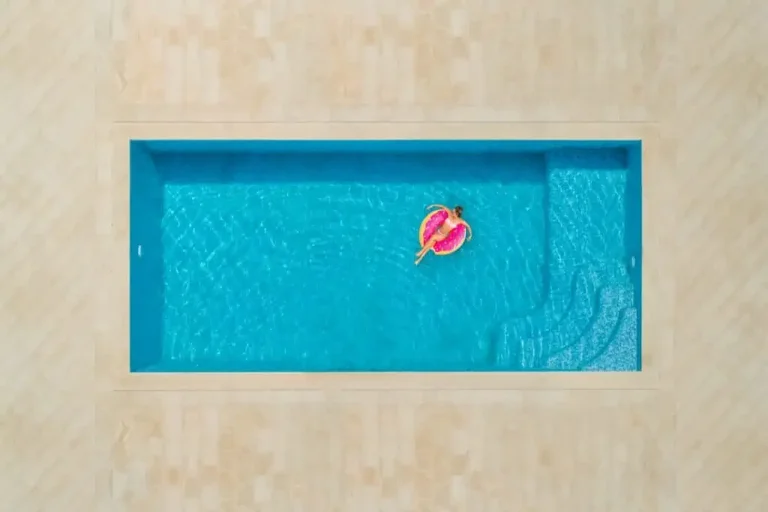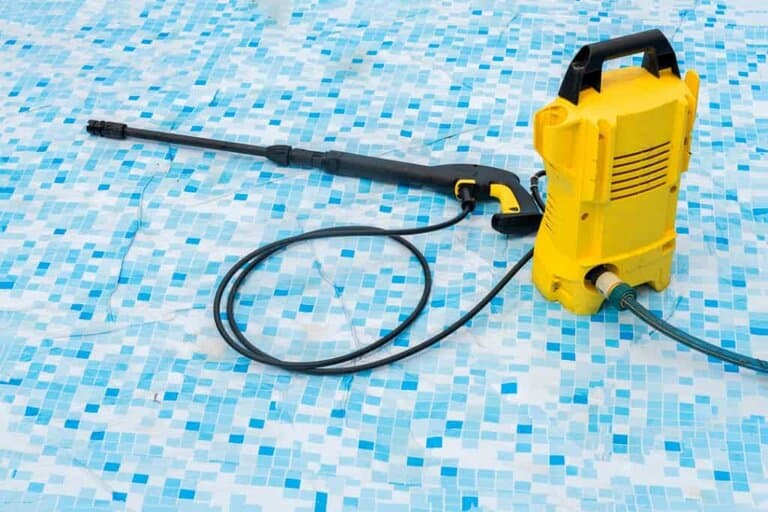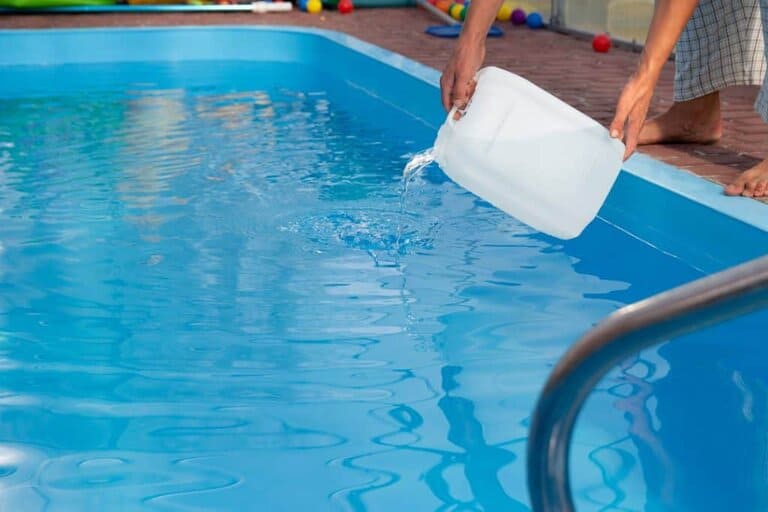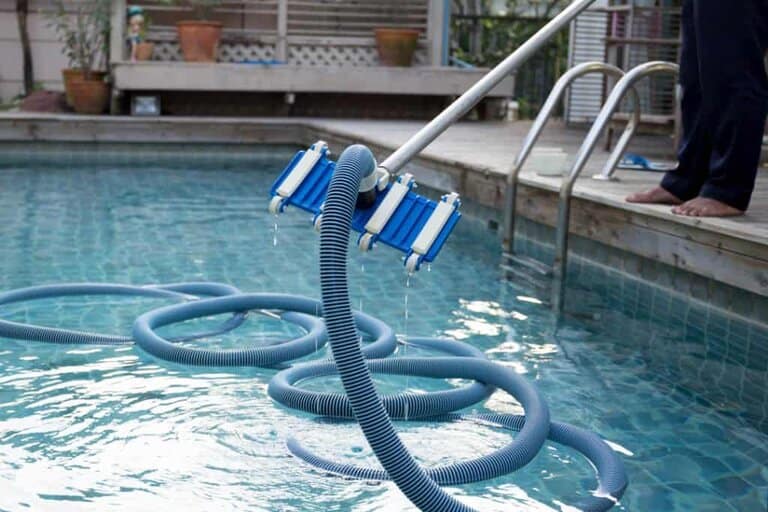To keep your pool clean without a pump, pour in half a cup of chlorine diluted with two liters of water. Wait for a few moments, until chlorine disinfects it. Another way is to grab a skimmer with a long head and skim through the pool surface to collect contaminants.
Since you’ve lost your pool pump, are you worried about your pool maintenance, or is it taking too long to get a new one? It might take some time before you’ll get your hands on one. And, who knows, until then it will become home to stubborn algae and other bacterial invasions.
Before getting further delays, try cleaning your pool with the methods discussed below. They don’t take long to implement and your pool will stay cleaner for longer.

Skimming Your Pool
Pool skimming is a convenient way to remove debris and surface pollutants from your pool. If you practice it daily, you won’t need sturdy pool maintenance services as it stops the debris from settling at the bottom.
There are two methods to skim your pool:
- Manual pool skimming
- Automatic pool skimming
Manual Pool Skimming
Manual pool swimming requires a bit of extra effort and hard work to flush out the surface pollutants accumulated due to wind. Although the results aren’t 100% after manual skimming for large pools, it is worth it if you don’t have a pump at the moment.
Supplies Required
- Skimmer net
- Telescopic pole
Method
- Grab the long end of the pole attached to the skimmer net or basket.
- Float it over the water’s surface and collect dried leaves, traces of algae, and other particles into the net.
- Once the net is filled, discard it into a disposable bag.
- Repeat until you get the desired results.
Automatic Pool Skimming
An automatic pool skimmer floats through the pool’s surface and can cleanly engulf everything that’s burdening your pool. These skimmers are very handy and save a lot of time and extra effort.
Supplies Required
- Automatic pool skimmer
Method
- Hook up your automatic pool skimmer to the wall of the pool.
- Let the skimmer do its job by floating on the surface through autopilot mode.
- It will collect every kind of debris in the net basket attached.
- Look for the basket to fill.
- Declutter it and follow up with the cleaning until completely done.
Benefits of Skimming Your Pool
- Skimming clears out rotten leaves or flowers.
- Prevents odor building in the pool by removing rotten debris.
- It protects the bottom from getting invaded with algae and other cluttering stuff.
- Skimming removes human hair that can be tough to remove otherwise.
Sanitize Your Pool With Chlorine
Treating your pool with the right amount of chlorine is the easiest way to keep up with the appropriate pool health.
Supplies Required
- Chlorine bleach – five ppm (5 oz per 1000 gallons of water).
- Fast dissolving chlorine tablets.
- Gloves.
Method
- Keep your hands safe from highly acidic chlorine with gloves.
- Take 5 oz of chlorine for 10,000 gallons of water in your pool. You can either add it directly or dilute it with water as one fourth cup of chlorine mixed with one liter of water.
- Pour into the sidewalls of the pool.
- Make sure the disinfectant is spread evenly on the sides of the pool.
- Wait for chlorine to get settled evenly throughout the pool.
Important Notes
- Since your pool isn’t appropriately filtered with a pump, the chlorine must be applied at 5 ppm and not the regular three ppm.
- Don’t use the chlorine-treated pool immediately.
- Wait until the water turns crystal clear as chlorine reactions can make it a bit cloudy.
- Use granulated chlorine for stable results.
Difference Between Regular Chlorine and Shock Treatment
- Simple chlorine uses liquid chlorine that is unstable when exposed to sunlight.
- Shock treatment is a high dose of chlorine.
- Shock treatment is highly stable and provides long-term disinfection.
- Shock treatment is quicker.
- Chlorine is cheaper than shock treatment.
Benefits of Chlorine Treatment
- Prevent algae growth.
- Protects against bacterial and other microbial activity in the pool.
- Prevents various viral (swimmer’s ear) and bacterial diseases caused by E. Coli and salmonella.
Pool Flossing
You have heard of dental flossing, but what is pool flossing? Pool flossing is a method of removing stubborn debris that sticks to the bottom of the pool or narrow edges. Flossing is carried out with specialized nozzle-like filter flossers that spray water with high pressure targeting sticky dirt and wastes.

Supplies Required
- Filter flosser.
- Garden hose.
Method
- Connect the filter with the garden hose.
- Start spraying over the polluted spots.
- Air and water pressure builds up while spraying.
- This pressure detaches debris and flushes them away.
- Remove the debris through a skimmer net or vacuum.
Benefits
- Pool flossing is easy to practice daily.
- It saves water while spraying it with pressure.
- Pool flossing is a faster way to collect debris on the surface.
- It provided a general cleaning with its curved nozzle design.
- It deeply cleanses the corners and edgy spots.
Clear Your Pool From Algae
Algae are the potential unwelcome guests if you’re out of your pool pump. These microbes won’t make you notice their appearance until they form large colonies. Algae makes your pool look untidy and causes an unpleasant odor.
It can also clog your pool’s clearance lines when your pump is out of order. So, clean your pool from algae in the first place.
Clearing Algae with Flocculants
Flocculants are supreme anti-algal chemicals or coagulants. With the correct method, your pool will become algae-free in the long term.

Supplies Required
- Flocculant
Method
- Make sure the PH of the pool is 7.0 before starting the process.
- Dilute the chemical according to the given instructions (on the carton).
- Mix flocculant with five gallons of water.
- Pour the mixture on the sides and edges of the pool generously.
- Manually stir the pool as you don’t have any pool pump.
- Algae will start clumping and will eventually settle down.
- Remove clumps with a skimmer or vacuum.
- Clean the pool filters thoroughly.
Benefits
- Keep algae and other microbes away for the long term.
- Flocculation is an easy and fast method to get rid of algal colonies.
- Flocculants clump up larger algae to traces of other microbes also.
Alternative methods
Calcium hypochlorite
Calcium hypochlorite is the most abundant form of chemicals that is used to kill algal invasion in the swimming pool. It is added to the pool on the basis of the algal color strength.
For example, teal or light greenish coloration requires only two pounds of calcium hypochlorite per 10,000 gallons of water in the pool.
Similarly, for extreme algal invasions with dark green to brownish, add three pounds of it.
- Add half a cup of calcium hypochlorite into one-liter water.
- Pour into the pool evenly.
- Give it rest for 10-15 minutes.
- Clear out the wastes.
Algaecides
Algaecides are potential algae preventing chemicals that not only kill the existing algal colonies but also protect your pool water against future contaminations. Copper sulfate is the basic antialgal ingredient used in most products available in the market.
- Mix 1 cup of algaecide in two liters of water.
- Pour in the pool and let it set.
- Clean the pool thoroughly.
Testing Chemical Levels of Your Pool
Frequent testing of the chemistry of the pool water is a compulsory job, whereas you’re trying to cater to it without a pump. In this condition, your pool becomes more vulnerable to bacterial invasions or disturbed PH levels because of the accumulations. An optimal PH is always necessary for a safer swimming experience for everyone.
Required Supplies
- A reliable water testing kit
Note that a reliable water testing kit has optimal preset levels of all chemical ingredients present in the pool water. You can find one from your nearest water testing labs.
Optimum Chemistry
- Calcium levels must be maintained at a range of 220-350. It is essential for plaster protection.
- Cyanuric acid levels must be kept under the 30-50 range. It is required to maintain chlorine stability against sun exposure by providing enough chlorine-free radicals.
- Regular Chlorine treatment to prevent germs invasions.
- The acidic or basic levels of the pool must be maintained at 7.5–7.8.
- To maintain a good effect on the skin and prevent plaster damage, PH levels should not exceed the 60-120 range.
Benefits
- Chemical testing guards pool water in the absence of a pump by not allowing wastes to build up.
- It keeps the water crystal clear and odorless.
Enhance Circulation to Keep Your Clean Without a Pump
Why do you even need an adequate water circulation method? Because water is as clean as its flow is. Stagnant water is home to countless wastes; flowing water just flushes them out.
Gone are the days when you only stuck to pumps to enhance your pool’s circulation. Now you can easily achieve the same results with the following methods:
- Vacuum cleaner.
- Siphoning method.
Vacuum Cleaner
Vacuum pool cleaners have gained immense popularity for their convenient handling and effective cleaning. Automatic robotic pool cleaners or vacuums are a handy option to go for and are available in a large variety on Amazon.
Some of the best performing vacuum cleaners are:
- Climb Wall Pool Cleaner by XtremepowerUS
- Zodiac MX6
- PAXCESS HJ1103

- Attach one end of the telescope pole to the vacuum head.
- You are free to access the bottom of the pool through the adjusted vacuum head.
- Now connect the vacuum head to the vacuum hose on one side.
- Reach out to the bottom of the pool with the help of vacuum head and hose, while keeping one end of hose outside the pool.
- Connect the free end of the hose to the water inlet. Water will start flowing through the hose.
- Wait for the hose to get full and vacuum head lying flat on the bottom.
- Connect the intake mode with the filter inlet.
- Keep the vacuum head aligned by the pool floor (use a telescopic pole).
- Once the wastes are sucked in, detach the hose.
Siphoning Method of Water Circulation
It is the simplest way to drain your pool and let fresh water in.
Method
- Look out for a spacious drainage spot.
- Take a hose of a considerable length.
- Connect one end with the tap and other with the pool.
- Turn on the tap and allow water to flow into the pool.
- After a few moments, turn off the tap.
- Point the detached hose from the tap towards the drainage spot.
- Water from the pool will start flowing towards the drainage.
- Once emptied, start refilling the pool with fresh water.
Brushing Your Pool
Last but not the least, brushing also helps in all the necessary cleaning and preventing wastes accumulation to build up.
Supplies Required
- Brush
- Gloves
Method
- Put on gloves and grab a brush with a long stick.
- Start rubbing off the dirt from the sides.
- Use a garden hose to spray water after brushing it.
- Make sure the water levels are optimal for a convenient brushing.
Benefits
- Cheapest pool cleaning option.
- Brushing your pool instantly removes the excess algal and other waste masses.
- It provides ideal cleaning for the ridgy spots and narrow corners .
FAQs on How to Keep Your Pool Clean Without a Pump
Is it alright to leave the pool without a pump for a longer duration?
It is alright until you are cleaning and filtering your pool regularly with proper cleaning methods. However, it’s good to install a pump as soon as possible.
Is chlorination done without using a filter?
Yes, you can add the right proportion of chlorine to your pool without a filter.
How to keep my pool clean naturally?
You can keep your pool naturally clean through DIY pool cleaners, pool covers, and skimming regularly.
Can you use household bleach to clean your pool?
Yes, you can use household bleach to clean your pool. It is also another form of chlorine and is a good ingredient to sanitize your pool.
Should I check water levels regularly?
Yes, it is necessary to check the water levels of the pool regularly. An outflow of water can considerably catch more debris.